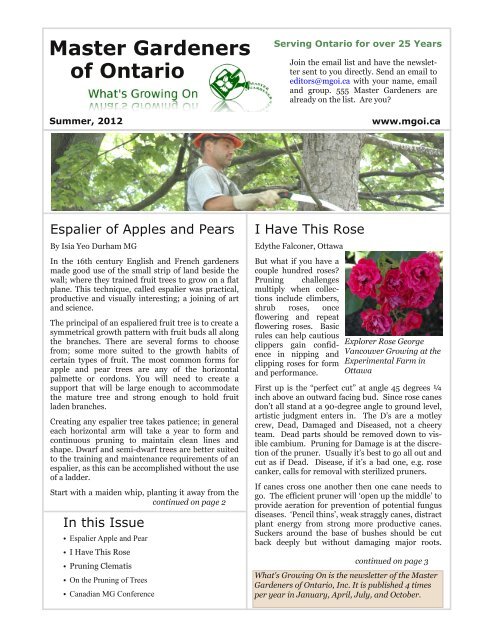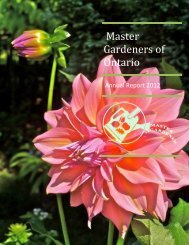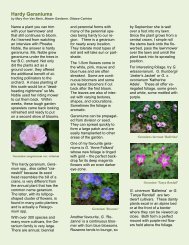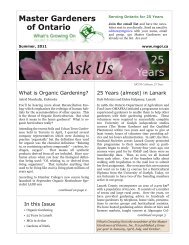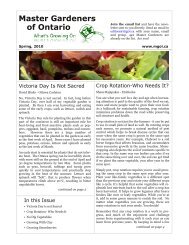You also want an ePaper? Increase the reach of your titles
YUMPU automatically turns print PDFs into web optimized ePapers that Google loves.
Page 2<strong>Master</strong> <strong>Gardeners</strong> <strong>of</strong> <strong>Ontario</strong> <strong>Summer</strong>, <strong>2012</strong>Espalier from page 1support, about 4 –6 inches, so it hasair circulation androom to grow. Thefirst set <strong>of</strong> budsshould be about18 inches abovethe ground and asclose to oppositeas possible asthese will be thelowest arms.pear espalier in the cordon styleDepending on theshape you are creating this may be all you arelooking for. In a double or triple cordon you willneed one other bud above these two, to become theleader. Cut on a 45 degree angle just above the topbud.When the buds are about 4 inches long you willwant to attach them to bamboo stakes, this is tokeep the branch as straight as possible whilegrowing. The bamboo can then be secured to yoursupport at the angle you need. The header issecured as straight as possible and the two lateralarms can be secured at a 45 degree angle andlowered as they continue to grow. The more verticala limb is the faster it will grow. Horizontal limbs areslower growing and produce fruit.The natural growth habit <strong>of</strong> a branch is to growvertical. If the tips <strong>of</strong> a horizontal branch are leftthey will turn up, this is how a design like acandelabra and a double upalmette are created. Itis very important to know what design you arecreating and that you plan your espalier, so that youleave enough space between arms and leaders toaccommodate the finished design. The distancebetween arms will need to be 12 – 18 inches.Leaders should be a minimum <strong>of</strong> 15 inches apart,but keep in mind the lowest arms will need to belong enough to allow for the number <strong>of</strong> leaders thatwill be formed between the central leader and theoutside leaders.General maintenance will begin from the time thetree is planted. Unwanted buds can be removed bygently rubbing them <strong>of</strong>f with your thumb. Cutlateral branches back to a single leaf. Pinch sideshoots at the base <strong>of</strong> the shoot once it has grown 3leaves past the whorl. Knowing when to pinchshoots from old fruiting branches is a little moredifficult, as weather and growing habits factor in. Ifthey are pinched too soon new shoots will form.Most apple and pear trees produce fruit along thearm <strong>of</strong> the tree or spurbearing. Fruit is producedon old wood, so be careful not to cut into the oldwood <strong>of</strong> the spur. As a tree matures it may need tobe rejuvenated, overcrowded spurs will need to bethinned.With continued pruning and attention to thegrowth <strong>of</strong> your espalier tree you can not only have abeautiful specimen in your garden, but also abountiful harvest.On the Pruning <strong>of</strong> TreesGary Westlake, Peterborough (published previouslyin the Peterborough Examiner)Trees do not grow the same as we do. They grow incircumference around their trunks and branches.They also grow at the tips <strong>of</strong> the branches. A branchthat begins from the trunk at a height <strong>of</strong> one metrefrom the ground will continue to grow from thiscontinued on page 8President: Ralph Bullough – president@mgoi.caTreasurer: Wendy Fletcher – treasurer@mgoi.caCorporate Secretary: Wendy Fletcher – secretary@mgoi.caPast President: James Lee pastpresident@mgoi.caDirectors:Zone 1: Donna Russell – zone1@mgoi.caZone 2: Linda Hugli – zone2@mgoi.caZone 3: Bob Worthy zone3@mgoi.caZone 4: vacantZone 5: Claudette Sims – zone5@mgoi.caMGOI Board <strong>of</strong> DirectorsZone 6: Lynne Marie Sullivan – zone6@mgoi.caZone 7: vacantZone 8: Kelly Noel – zone8@mgoi.caZone 9: Pam Love & Janice Hardy zone9@mgoi.caZone 10: Tena Van Andel & Jane Beck zone10@mgoi.caZone 11: vacantNewsletter: Dianne & Gary Westlake – editors@mgoi.caMG Listserve: Kelly Noel – listcoordinator@mgoi.caWebsite: Linda Hugli webmaster@mgoi.caOMAFRA Representative: Helen Scutt – omafra@mgoi.caProvincial Administrator:Charlotte Vorstermans – info@mgoi.ca 113 Mill Street, Creemore, ONLandscape <strong>Ontario</strong> Rep: Denis Flanagan – landscapeontariorep@mgoi.caOHA Rep: Judith Rogers oharep@mgoi.caL0M 1G0
<strong>Master</strong> <strong>Gardeners</strong> <strong>of</strong> <strong>Ontario</strong> <strong>Summer</strong>, <strong>2012</strong> Page 3Roses from page 1Timely removal <strong>of</strong> older, less productive canes encouragesyounger cane growth.Pruning roses is an ongoing process. Ideally pruningto control Ds and form should be done beforethe buds break dormancy. In nature, <strong>of</strong> course, Dsand their companion problems can occur at anytime. Cane borers are an unpleasant example <strong>of</strong>this need.Deadheading is especially important for repeatbloomers. Neglect this job and the second bloommay be less than satisfactory. Depetalling is an optionin late summer if hips are desired for winterviewing. Roses that bloom on last year’s growthshould not be pruned in the spring. However in Ottawathe rabbits or Old Man Winter usually makethis caution irrelevant.Climbers are the peacocks <strong>of</strong> the rose world. Six orseven strong canes can be arranged in the shape <strong>of</strong> afan with each pruned to roughly the same length.Each side branch <strong>of</strong> each main cane can be cut backto two or three buds. Some remaining canes can beretained as backups in case <strong>of</strong> damage. Do this inearly or late winter when the roses are dormant.Whole books can be written on the gentle and not sogentle art <strong>of</strong> pruning roses. However sometimesbooks are more daunting than roses. Roses aretough. Feed them, water them and don’t let themget straggly. Other than that they are very hard tokill.Pruning ClematisIsabel Belanger, EtobicokePruning clematis may seem complicated, howeverclematis is quite forgiving and will grow and bloomwhether you prune it or not. It will also grow if youprune it to the ground, but may not produce flowersin that particular year. Pruning clematis properly,though, will optimize growth and flowering,resulting in a more productive vine.Knowing to what group your clematis belongs is keyas clematis is pruned according to whether itbelongs to group A, B, or C (1, 2, or 3).Group A (1): are early spring blooming clematisthat flower on the previous year's growth, on shortflower stalks emanating from a leaf axil. It isimportant not to prune group 1 until after theyflower, albeit as soon as possible after flowering.Pruning is done primarily to remove dead and weakstems, or to containgrowth. Large old vinescan be pruned fairly hard,down to some vigorousgrowth, however vinesmay take a year to recoverand flower again. Speciesin group 1 include alpina,macropetala, andmontana.Group B (2): produceflowers from the previousyear's growth, but <strong>of</strong>tenGuernsey Creamproduce flowers on thecurrent year's growth.Cultivars include early large flowering, double andsemidouble, and midseason large floweredclematis. Group 2 is the most complicated toprune.Dead and damaged tips <strong>of</strong> the stems should bepruned in late winter/early spring, once the leafaxil buds begin to swell. The plant should beshortened by about 510", working down from thetips, following each stem until you come to a pair<strong>of</strong> large, swelling leaf axil buds. Ray Evison, thewellknown clematis grower, recommendsstaggering the height <strong>of</strong> the stems slightly, pruningtwo or three <strong>of</strong> the stems down to 12 feet toencourage fresh growth at the base <strong>of</strong> the plant.Check out Ray Evison's advice on his websiteraymondevisonclematis.comGroup C (3): are the easiest types to prune. Theyflower later in the season on new growth andtherefore can be pruned hard depending on the age<strong>of</strong> the plant. In early winter/late spring, all theprevious season's growth should be cut back to atleast 30" from the ground for established plants,again to a swelling leaf bud axil; younger plantsshould be cut back further to establish bushiergrowth. Viticella and Texensis species, as well asthe popular jackmanii are included in Group 3.Comment on WormsCatherine Kavassalis, Halton MGsI am concerned with the article on earth worms.We continue to spread the notion that earth wormsare beneficial. They are invasive species and can dogreat harm to forest ecosystems. We should informMGs <strong>of</strong> the alternative perspective well expressedhere:http://www.dnr.state.mn.us/invasives/terrestrialanimals/earthworms/index.html
Page 4<strong>Master</strong> <strong>Gardeners</strong> <strong>of</strong> <strong>Ontario</strong> <strong>Summer</strong>, <strong>2012</strong>EventsJuly 7 from 10:00 a.m. to 4:00 p.m. – BobcaygeonGarden Tour. Admission $15.00. Haliburton MGswill have an advice clinic. Contact Linda Friend(Bobcaygeon Horticultural Society) atlindafriend2005@yahoo.caJuly 14 and 15 – The 5th Annual M.G.O.I. <strong>Summer</strong>Workshop will be held at the Niagara ParksBotanical Gardens and School <strong>of</strong> Horticulture.Three topics are being <strong>of</strong>fered: An InvestigativeTour <strong>of</strong> Insects and Diseases that AffectConiferous and Deciduous Trees; An InvestigativeTour <strong>of</strong> Insects and Diseases that Affect SelectedShrubs, Perennials, Annuals and Turf; The UrbanFarmer – Growing Fruit and Vegetables Close toHome. Further information go to www.mgoi.caand you will find the Programme Outline on thehome page. For more contact June Streadwickstreadwick@sympatico.ca or 9059346137.Saturday August 18 from 2:00 – 4:00 p.m. at beautifulRock Wall Gardens just east <strong>of</strong> Perth – LanarkCounty <strong>Master</strong> Gardener group celebrates 25Years in Lanark County with an Open Housefeaturing demos and desserts.September 4 – 7:00 p.m. at Minden Community Centre –Presentation by Haliburton group to the MindenHorticultural Society on Concepts in GardenDesign. Contact Janice Hardy athalmastergardener@gmail.comSeptember 8 – 2:00 5:00 p.m. – North York GardenClub Annual Flower and Vegetable Show and Café.Please note: New Location – EdithvaleCommunity Centre, 131 Finch Avenue WestSeptember 17 – 21 – Fall in the Hudson River Valley –Gardens and Estates <strong>of</strong> the Hudson River Valleypresented by the Northumberland <strong>Master</strong><strong>Gardeners</strong>. Includes return coach transportation,shared accommodation with hot buffet breakfast,all garden entrance fees. $675.00 Canadian(Single Supplement add $350.00.) For moreinformation contact Helen Lackey 9053779803or helen.lackey@gmail.comOctober 13 – The 6th Annual Coordinators’ Conferencewill be held at the Landscape <strong>Ontario</strong> facility inMilton.October 20 – Technical Update at the Simcoe CountyMuseum in Midhurst, details to follow.Sept 29 – 12:30 to 4:00 p.m. at the Stoney Creek YMCACommunity Centre, 920 Sunningdale Road Eastin London – London Middlesex is hosting a 'FallEvent' with a speaker from a commercial bulbgrower talking about the 'Dig, Drop, Done' bulbprogramme and a presentation on ‘Saving Seeds’by a representative <strong>of</strong> Seeds <strong>of</strong> Diversity. Cost is$5.00 per person and no registration is necessary.Proceeds will be donated to 'Growing Chefs<strong>Ontario</strong>' (www.growingchefsontario.ca)MilestonesNew MGiTsEtobicoke – Christine SpenceGrey County – MargaretAnn BrennanHaliburton County – Janet Divell, Milka HiderHalton Region – Valerie Love, Elizabeth Richards,Christine Says, Chris Sch<strong>of</strong>ieldNorthumberland – Marion JeanOttawaCarleton – Judith Courteau, Caroline Dabrus,Leah WalkerPeterborough – Anne English, Mary Jane (MJ) PilgrimStratford – Maureen Cocksedge, Robyn Gallimore,Michele H<strong>of</strong>fleKing, Susan McLennan, whotransferred from the disbanded Oxford groupNew MGsBrantford – Vae Hammett, Christa Hunter, Larry Sagar,Anne SaundersNorthumberland – Marli BeerPeterborough – Margaret Higgins5 YearsElgin County – Agnes BurroughsOttawaCarleton – Gail Labrosse10 YearsLanark County – Dale OdorizziNorthumberland – Betty DeLongOttawaCarleton – David Hinks15 YearsElgin County – Bob Fox, Gail Jacques, Helen Smith,Brenda Swindell, Diane VaughanNorthumberland – Ann SlemmingSudbury – Joanne MacLellan20 YearsSudbury – George Stassen25 YearsSudbury – Enzo Floreani, Tina Hansen<strong>Ontario</strong> Horticultural Association and<strong>Master</strong> <strong>Gardeners</strong> <strong>of</strong> <strong>Ontario</strong> Inc.WorkingTogetherHere is the latest issue OHA's newsletter the Trillium.
<strong>Master</strong> <strong>Gardeners</strong> <strong>of</strong> <strong>Ontario</strong> <strong>Summer</strong>, <strong>2012</strong> Page 5The Survey Says?If you were advising a new gardener, what plantswould you suggest that they choose for a shadyarea and why? Click on this link to give us youropinion and we will publish the results next issue.Just fill in this form and click on the submitbutton. We ask that you provide your name andgroup so that we know that you are not one <strong>of</strong>those nasty cyber robots. Please send us yoursuggestions for other short surveys we canchallenge <strong>Master</strong> <strong>Gardeners</strong> with.MGs in Action25 Years CelebrationSudbury MGs are celebrating their 25th anniversary thisyear. In addition to the annual Plant Sale, organized inconjunction with the Sudbury Horticultural Society at theGardening Festival, they were pleased to present ‘AnEvening with Denis Flanagan’. Denis entertained thecrowd and the evening was very successful! They werealso pleased to award Honorary MG status to WayneHugli.CelebrationsCongratulations to the following groups on theiranniversaries:10 years – Norfolk County15 years – Guelph and Wellington County25 years – Lanark, SudburyFrom Seeds to Your TableNancy Abra, London Middlesex (originally publishedin The Londoner)MGs and participants <strong>of</strong> the London MiddlesexcourseA sense <strong>of</strong> pride was the consensus from both thestudent gardeners and their <strong>Master</strong> Gardener instructorsat the final class <strong>of</strong> the course ‘From Seedsto Your Table’ last month. The eight week gardeningcourse covered the basic steps <strong>of</strong> learning aboutthe soil and compost, starting seeds, information onweed, insect and disease management to variousgarden concepts <strong>of</strong> growing vegetables, herbs andflowers, as well as preserving the harvest throughdrying, freezing and canning.The ‘From Seeds to Your Table’ course was developedby the London Middlesex <strong>Master</strong> <strong>Gardeners</strong>in partnership with the Friends <strong>of</strong> the LondonCivic Garden Centre and the London CommunityResource Centre (LCRC). The twentyone communitygarden plots throughout the City <strong>of</strong> Londonare managed by the LCRC. The need for thiscourse was evident as more and more people wantto grow their own food but lack good basic gardeningskills. The partnership hoped for an initial class<strong>of</strong> about 10 participants; 63 people registered.Three classes <strong>of</strong> twenty were accommodated.Linda Davies, Executive Director <strong>of</strong> the LondonCommunity Resource Centre said, “I have thegreatest respect for these <strong>Master</strong> <strong>Gardeners</strong> andtheir commitment to educate others to enhancetheir gardening experience. This gardening coursehas not only strengthened the partnership that wasalready in place with LCRC but it also provided the<strong>Master</strong> <strong>Gardeners</strong> with the chance to connect withcommunity gardeners.” Davies continued by stating,“Community gardeners by their very naturelike to share their experiences so the informationwill reach beyond those who attended the course.The turn out each week speaks to the enthusiasm<strong>of</strong> the gardeners and the final evaluation reaffirmedtheir enjoyment <strong>of</strong> the course.”Gail Dimson, General Manager, <strong>of</strong> The Friends <strong>of</strong>the London Civic Garden Complex, stated that shesaw the need for this type <strong>of</strong> course but did nothave the volunteers to present it. Community partnershipscan accomplish more than going it alone.Participants in the course seemed to agree. On thefinal evaluations participants raved about an excellentcourse with comments like, “Thank you for avery valuable experience, I highly recommend thiscourse to anyone who wants to garden!”The London Middlesex <strong>Master</strong> Gardener Coordinator,Donna Slater said, “I am so delighted we havesuch forward thinking people in our <strong>Master</strong>Gardener group. Two members, Dorothy McGeeand Nancy Abra, saw a need for basic gardeningknowledge that has been lost by many people <strong>of</strong>the last generation for reasons such as urban living,busy fast lives filled with frozen pizza and grocerystore convenience.” Slater continued byexplaining, “ As the idea moved ahead, partnershipswere developed and a successful start tosmall urban agriculture in London came about.Carrots come from dirt and salsa is made from tomatoes!”Slater declared, “And I am very proud <strong>of</strong>our <strong>Master</strong> <strong>Gardeners</strong>”.
Page 6<strong>Master</strong> <strong>Gardeners</strong> <strong>of</strong> <strong>Ontario</strong> <strong>Summer</strong>, <strong>2012</strong>The Last MysteryeditorsThe mystery plant was guessed as Caulophyllumthalictroides – Blue Cohosh by CatherineKavassalis – Halton, Janet Trezise – LSSMG, andCathy Dueck – Honorary MG and Manager,Landscape Programs Peterborough Green Up.Cathy also added that it's a lovely woodland plant(hard to propagate though as its seeds sometimestake 4 to 5 years to germinate). When it's emergingin the spring it looks like a purple claw.We are giving the Mystery Plants a rest for a while.Pruning Article On theHaliburton WebsiteJanice Hardy Haliburton <strong>Master</strong> GardenerOne <strong>of</strong> the most important aspects <strong>of</strong> tree andshrub management is knowing how and when toprune – done correctly the specimen will be notonly aesthetically pleasing but healthy. Pruning isnot difficult once you understand the basics <strong>of</strong>how, why and when to prune.There are several reasons why gardeners shouldprune trees and shrubs. Pruning should be done topromote health and growth by removing dead ordying branches injured by disease, insectinfestation, storms or other damage. Branches thatare rubbing together will eventually create anopportunity for disease so one <strong>of</strong> the two should beremoved. Disinfect tools between cuts if disease ispresent or suspected.The development <strong>of</strong> a strong framework indeciduous trees through proper thinning andformative training will help prevent disease andloss <strong>of</strong> vigour while maintaining the natural form<strong>of</strong> the tree. Ideally a tree should be pruned to allowa few strong limbs well spaced apart up and downthe trunk. Pruning begins with the young tree andcontinues over a period <strong>of</strong> time, as the tree getslarger. Evergreen trees rarely need pruning, asthey tend to develop a strong structure naturally.Pruning can also be done to rejuvenate older treesand shrubs. In trees, pruning part <strong>of</strong> the crownincreases air circulation and reduces the leaf areathat the root system supports. The remainingbranches will grow more vigorously enhancing thehealth and appearance <strong>of</strong> the tree. Larger branchesneed to be pruned using a threestep cut method toreduce the weight <strong>of</strong> the branch. The first cut isdone from underneath at about 30 cm from thetrunk. This is to prevent the branch from breaking<strong>of</strong>f and tearing the bark. The second cut is done alittle further out on the branch from the first cutuntil the branch breaks away. The third cut isdone just outside the branch collar.Pruning is also done to maintain the intendedpurpose in the landscape: encouraging flower andfruit development; maintaining a dense form for aprivacy hedge; maintaining a desired shape;improving bark or foliage colour for winter interestin some species (e.g. dogwoods, heather). Size canbe managed if needed but ideally trees and shrubsare selected with existing space in mind.Plant appearance can be improved throughjudicious pruning. For most landscapes, theplant’s natural form is <strong>of</strong>ten the most desired.Pruning can be done to control the plant size asmay be the case with both shrubs and trees. Lightpruning will keep evergreens wellproportionedand looking good. Branches and undesirablefruiting structures that detract from the overallappearance <strong>of</strong> the plant can be removed.Pruning for safety – to protect people and property– should also be done. This means removing deadbranches, pruning out narrowangled treebranches that overhang homes and walkways oranywhere that a falling limb might cause injury orproperty damage. Hazardous trees may have to betaken down by a qualified tree removal service.Crown lifting may need to be done for trees nearwalkways and roads. This entails removing lowerbranches for the clearance requiredPruning for special effects such as topiary, bonsaiand espalier can also be done with specific pruningtechniques.The appropriate pruning tools should be used forthe job at hand. Hand secateurs can be used toprune young trees and most shrubs. Loppers are agood choice for somewhat larger tree branches anda pruning saw – either manual or motorized – isbest for large branches greater than eightcentimeters in diameter. Be sure to use the righttool for the size <strong>of</strong> branch: if the branch does not fitnicely into the jaws <strong>of</strong> the tool, it is time to moveup to the next. Tools need to be rust free andsharp. If disease is present, tools must bedisinfected after each cut.There is much useful information on the variousMG group websites like the article above. Checkthem out through the links on mgoi.ca.
Page 8<strong>Master</strong> <strong>Gardeners</strong> <strong>of</strong> <strong>Ontario</strong> <strong>Summer</strong>, <strong>2012</strong>On Pruning Trees from page 2Tree branches should be pruned just outside thecollar so that the tree can cover the wound asquickly as possible.height for the rest <strong>of</strong> the life <strong>of</strong> the tree unless thebranch dies or is taken <strong>of</strong>f. Trees also respond differentlyto injury than we do. Instead <strong>of</strong> trying torepair a damaged area, trees abandon it and wall it<strong>of</strong>f from the rest <strong>of</strong> the tree to prevent the spread <strong>of</strong>disease and the entry <strong>of</strong> insects.You would think that trees, whose ancestors havebeen growing for thousands <strong>of</strong> years, would notneed any help from us to grow properly to maturity.However, trees that are adapted to grow in forestenvironments, will not necessarily perform well inopen areas or urban locations without a little pruning.The forest is very different from the placeswhere we want these trees to grow because theforest floor is covered with decomposing leaf litterand in the forest, the trees sprout up close to eachother competing for light. Successful individualtrees will stretch straight and tall for a piece <strong>of</strong> thesun. As they do so, the lower branches are cast <strong>of</strong>fearly while they are small and the only ones left areat the top in the canopy.Trees growing in open urban settings without pruningtend to look chaotic with branches going in alldirections and at all angles from the trunk. They donot have the normal forest cues for growth and theyend up with weak branching and with too manybranches. But a little pruning in the first few years<strong>of</strong> these trees lives can make a great difference.It is not good to prune a tree for a couple <strong>of</strong> yearsafter planting so that it can get safely through thetrauma <strong>of</strong> having its roots slashed and so that it canadjust to a completely new environment.The first thing you need to keep in mind is to protectthe central leader so that the tree can growstraight and free <strong>of</strong> disease down through its centralcore. If for some reason, the leader gets lost,then you need to create one by selecting anotherbranch and allowing only one to reach for the top.If the leader is removed later in the tree’s life, itopens a channel directly from the top for waterand rot to take out the supporting wood in thecentre <strong>of</strong> the trunk. So one <strong>of</strong> the worst things youcan do to a tree is top it in an attempt to restrict itsheight.The next thing you need to do over the first fewyears is to decide where the lowest branches willbe and as the young tree grows, gradually removebranches until you get to the desired height. Asyou do this, look at how the other branches come<strong>of</strong>f the trunk. Any that are at steep angles shouldbe removed because they will produce weak connectionsto the trunk where ice can accumulateand cause damage.If you realize that the leaves <strong>of</strong> the tree will competewith each other for available light, then pruningwill be easier. If leaves do not get enough light,they and the branches that carry them will die.This is why hedges are dead in the middle. You canassist by pruning <strong>of</strong>f some branches so that theyare evenly spread and so that they do not interferewith each other both vertically and around thetrunk. Not only will this help the tree maximize thelight to the leaves, but it will also allow the air t<strong>of</strong>low through which reduces disease and improvesphotosynthesis, respiration and transpiration.Leave some room for the birds to fly through. Ifyou are pruning an apple tree, you should be ableto throw your hat through the tree when you finish.There are two additional benefits: the tree willlook natural as if it were growing in the forest; andthe tree will be strong, resistant to disease, insectsand storm damage. A small amount <strong>of</strong> work duringthe first few years <strong>of</strong> the tree’s life will prevent veryexpensive and dangerous work later.Although it is natural to want the tree to be largeas soon as possible, you need to resist the urge toplant large trees. If you plant a tiny whip next to aten foot tree, the whip will catch up to the ten footerin a few years because the larger tree undergoesa lot <strong>of</strong> trauma and has to recover more. The treeplanted smaller will be stronger in the end becauseit will adjust to the site as it grows. Trees bend tothe prevailing winds and strengthen their trunksand branches in the direction needed. Moving atree eliminates this process.


